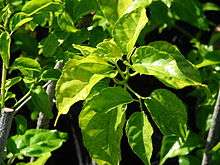Colubrina
Colubrina is a genus of about 30 species of flowering plants in the family Rhamnaceae, native to warm temperate to tropical regions of Africa, the Americas, southern Asia, northern Australia, and the Indian Ocean islands. Common names include nakedwood, snakewood, greenheart and hogplum. The generic name is derived from the Latin word coluber, meaning "snake", and refers to the snake-like stems or stamens.[3]
| Colubrina | |
|---|---|
 | |
| Colubrina asiatica | |
| Scientific classification | |
| Kingdom: | Plantae |
| Clade: | Tracheophytes |
| Clade: | Angiosperms |
| Clade: | Eudicots |
| Clade: | Rosids |
| Order: | Rosales |
| Family: | Rhamnaceae |
| Genus: | Colubrina Rich. ex Brongn., 1826[1] |
| Type species | |
| Colubrina ferruginosa Brongn.[2] | |
| Species | |
|
See text | |
| Synonyms | |
|
Barcena Dugès | |
The species are shrubs and small trees growing 1–10 metres (3.3–32.8 ft) tall, with simple ovate leaves. The flowers are small, greenish-white or yellowish; the fruit is a capsule containing three seeds.
The genus is at least in part a wastebasket taxon, and revision will likely result in the renaming of a number of species to different genera.[4]
Colubrina asiatica, native to tropical Asia, eastern Africa and northern Australia, has become an invasive species in Florida.
Selected species
- Colubrina angustior (M.C.Johnst.) G.L.Nesom (eastern Mexico)[5]
- Colubrina arborescens (Mill.) Sarg. – Greenheart (southern Florida, southern Mexico, the Caribbean, Central America)
- Colubrina articulata (Capuron) Figueiredo
- Colubrina asiatica (L.) Brongn. – Asian nakedwood, ʻĀnapanapa kukuku (Hawaiian)[6] (Indo-Pacific)
- Colubrina beccariana Warb. (Malaysia)
- Colubrina californica I.M.Johnst. – Las Animas nakedwood
- Colubrina cubensis (Jacq.) Brongn. – Cuban nakedwood (southern Florida, The Bahamas, Cayman Islands, Cuba)
- Colubrina decipiens (Baill.) Capuron
- Colubrina elliptica (Sw.) Brizicky & W.L.Stern – mabi, soldierwood (Florida Keys, Mexico, the Caribbean, Central America, Venezuela)
- Colubrina ferruginosa Brongn.
- Colubrina glandulosa Perkins – glandular nakedwood
- Colubrina greggii S.Watson – Sierra nakedwood
- Colubrina humbertii (H.Perrier) Capuron
- Colubrina nicholsonii Van Wyk & Schrire – Pondo snakewood, Pondo weeping thorn, Afrikaans: Pondo-treurdoring[7]
- Colubrina oppositifolia Brongn. ex H.Mann – kauila (Hawaii)
- Colubrina pedunculata Baker f. (Christmas Island)
- Colubrina pubescens Kurz
- Colubrina stricta Engelm. ex M.C. Johnst. – Comal nakedwood
- Colubrina texensis (Torr. & A.Gray) A.Gray – snakewood or Texan hogplum (Texas, northern Mexico)
- Colubrina verrucosa (Urb.) M.C.Johnst. – Urban's nakedwood[8][9][10]
- Colubrina yucatanensis (M.C.Johnst.) G.L.Nesom (Yucatán Peninsula)[5]
Formerly placed here
- Alphitonia excelsa (Fenzl) Reissek ex Benth. (as C. excelsa Fenzl)[9]
Ecology
Colubrina species are used as food plants by the larvae of some Lepidoptera species including Bucculatrix kendalli which feeds exclusively on C. texensis.
Uses
In the Caribbean, the leaves and/or fruit and in some cases the bark of some species are used to produce a soft drink called mauby.
References
- "Genus: Colubrina Rich. ex Brongn". Germplasm Resources Information Network. United States Department of Agriculture. 2007-10-05. Archived from the original on 2009-05-06. Retrieved 2009-04-05.
- "Colubrina Rich. ex Brongn". TROPICOS. Missouri Botanical Garden. Retrieved 2009-10-01.
- Quattrocchi, Umberto (2000). CRC World Dictionary of Plant Names. I: A-C. CRC Press. p. 588. ISBN 978-0-8493-2675-2.
- Phillipson, P.B. (2007-07-22). "Colubrina Rich. ex Brongn". A Catalogue of the Vascular Plants of Madagascar. eFloras.org. Retrieved 2009-10-01.
- Nesom, Guy L. (2013). "Taxonomic Notes on Colubrina (Rhamnaceae)" (PDF). Phytoneuron. 4: 1–21.
- Bornhorst, Heidi Leianuenue (2005). Growing Native Hawaiian Plants: A How-to Guide for the Gardener (2 ed.). Bess Press. p. 52. ISBN 978-1-57306-207-7.
- "Protected Trees" (PDF). Department of Water Affairs and Forestry, Republic of South Africa. 3 May 2013. Archived from the original (PDF) on 2010-07-05.
- "Colubrina Rich. ex Brongn. Subordinate Taxa". TROPICOS. Missouri Botanical Garden. Retrieved 2009-10-01.
- "GRIN Species Records of Colubrina". Germplasm Resources Information Network. United States Department of Agriculture. Archived from the original on 2009-01-20. Retrieved 2010-10-16.
- "Colubrina". Integrated Taxonomic Information System. Retrieved 2010-01-25.
External links
| Wikimedia Commons has media related to Colubrina. |
| Wikispecies has information related to Colubrina |